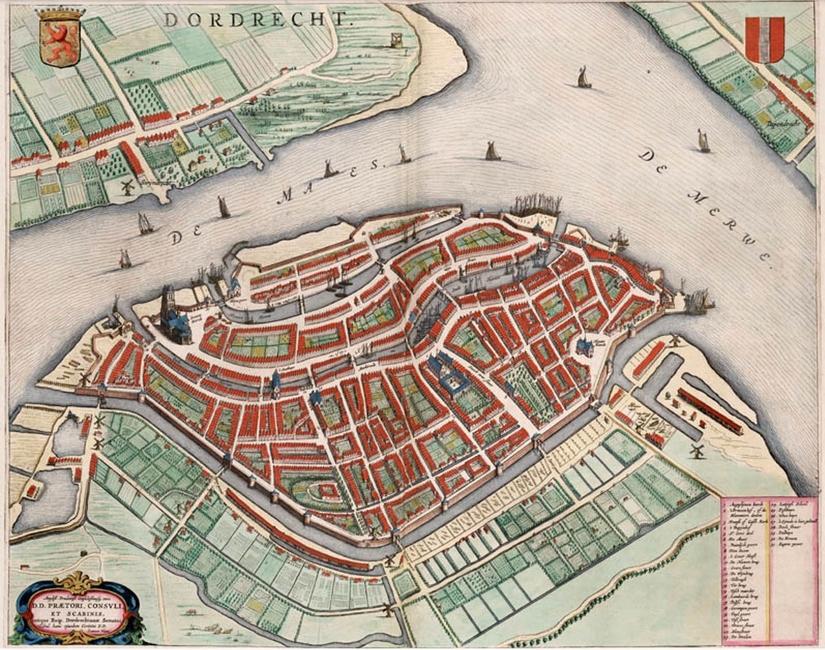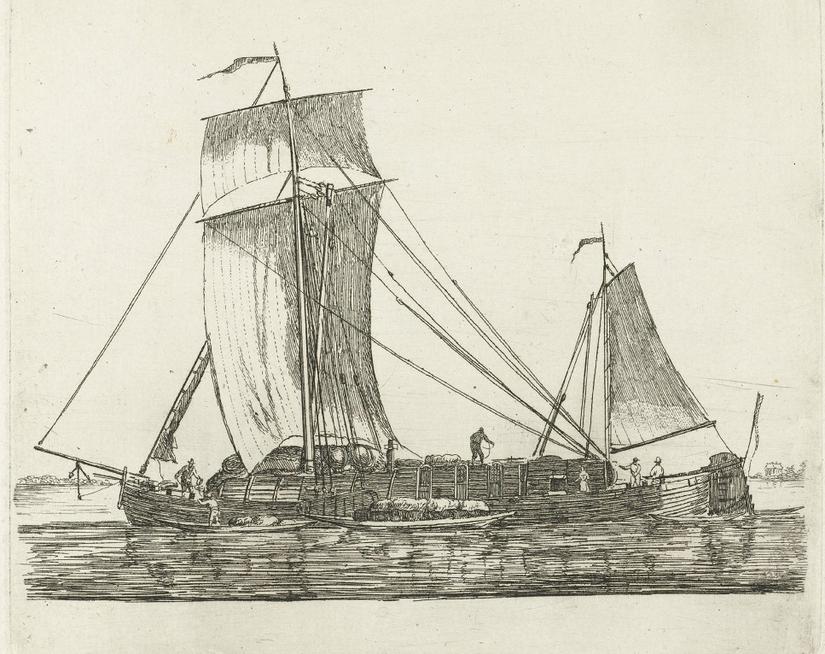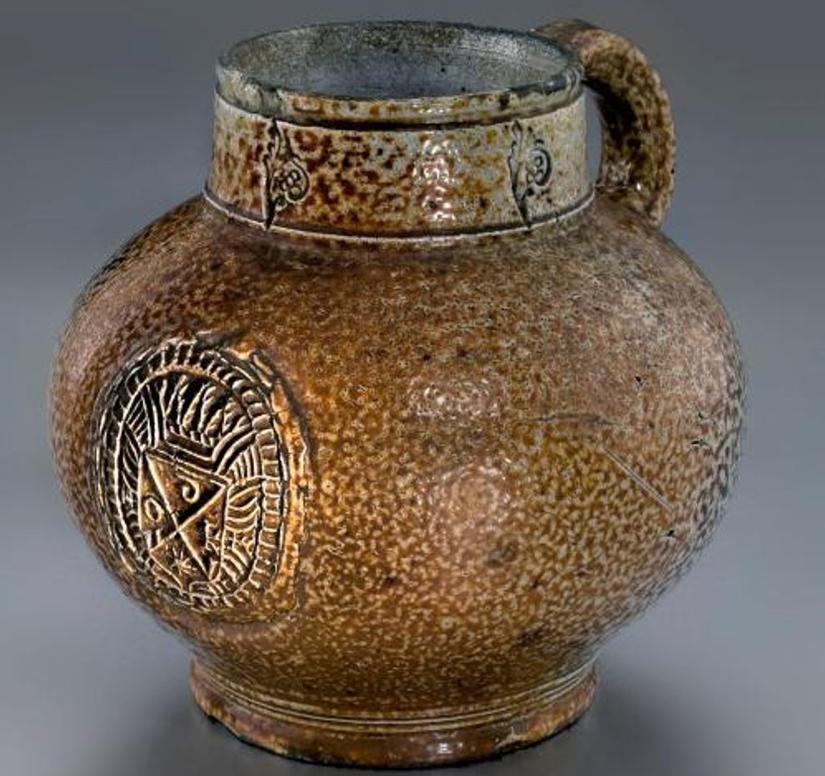The easiest route to transport stoneware produced in the Rhineland to markets in wider Europe and the colonial world abroad, was down the Rhine to the ports of Holland. Here the goods could be transferred from river boats to seagoing vessels.
The most important of these ports was the city of Dordrecht, located at the intersection of several waterways. Through the Waal and Rhine rivers Dordrecht had access to the Rhineland and beyond, while the River Meuse brought in Belgium’s timber and iron products. The city was easily accessible for seagoing ships and was connected to major ports, including Middelburg, Vlissingen and Antwerp to the south, and Rotterdam and Schiedam to the north.
The staple rights
Since the late 1200s, Dordrecht had stapelrecht (staple rights) granted by the Counts of Holland. This meant that anyone trading goods through the city’s port had unload their goods at and display them for sale at Dordrecht’s market, before they could transport them on to other cities. The staple rights provided an economic boost for Dordrecht, and gave it a huge advantage over other cities involved in trade from Germany, especially in the imports of wine, timber, and grain. The staple rights were only formally revoked in 1795, but floods in the 1420s and the growing opposition of other cities made it more and more difficult for Dordrecht to enforce its rights. However, throughout the 1500s-1700s Dordrecht remained the most important river port in Holland.

Professions in the stoneware trade
The importance of stoneware pottery such as Bartmann jugs early modern Dordrecht can be seen in the presence of specialised professions in the city.
Jug traders and counters
There are many references in historical sources to specialist kannenkoopmannen – jug traders – and kannentelders – jug “counters” who would be present at the unloading of the river ships and would assess the number and quality of the jugs.
“Rhine skippers”
The key profession that fostered the connection between Dordrecht and the Rhineland were the so-called “Rhine skippers”. The large barges which sailed up and down the Rhine were frequently owned by a family who lived on board ship for extended periods of time. Their vessels were loaded with large quantities of stoneware. In August 1656 Lambert Cornelissen van Bochem, a jug counter, declared that he had overseen the unloading of 58,400 worp of stoneware jugs from a Rhine barge called St Pieter.

Merchants
After unloading at Dordrecht, many jugs were destined to London. Some skippers could perhaps make the transition to merchant. The merchants didn’t just trade jugs made in the Rhineland. They also provided goods on credit for their contacts in Cologne and beyond. In some cases, they also seem to have directly invested in the jugs’ production as well.
Jan op de Kamp appears frequently as a skipper in legal documents in Dordrecht, often delivering loads of stoneware to the most prominent stoneware merchants of the time. In July 1645, for example, he was recorded as delivering a cargo blue-glazed jugs to Pieter Jaspers Leijsten, as testified to by the latter’s wife Geertruijdt Struijs, herself the daughter of an important stoneware merchant. Jugs and mugs with the merchant mark of Jan op de Kamp have been found in London and Virginia, in the latter case dated to the mid-1660s. Evidently, by then Jan op de Kamp was in a position to place orders with stoneware producers in his own name.

The notaries
Dordrecht has an extensive archive of notarial documents. We can gather a lot of data about the trade in Bartmann jugs from these and use them to create a detailed reconstruction of the stoneware traders’ and merchants’ networks. Notaries are lawyers who authenticate documents and transactions. Although not all transactions were documented with a notary, large transactions, long-term agreements, or transactions which involved credit were often recorded.
Notorial documents also record disputes and disagreements between merchants. In May 1630, notary Dirck Coplaer was sent to Pieter Struijs (also: Struce) on behalf of Nicolaes Hompe of Cologne to ask Struijs to repeat what he had said about Hompe to two other men. Struijs admitted he had called Hompe a schelm (rogue), but that Hompe had in fact insulted him first.
Overseas connections
The city of Dordrecht itself was not represented in the Dutch East India Company, although it did have a stake in the West India Company, founded in 1621. However, merchants in Dordrecht (or closely associated with the major traders in stoneware in Dordrecht) were involved in the overseas spread of German stonewares – primarily Bartmann jugs – to Asia and the Americas. In the 1600s, the Struijs family (including Pieter Struijs from the dispute mentioned above) was one of the dominant families in the business. In 1606, Garstiaen Struijs delivered “bottles”, likely jugs from his contacts in Dordrecht, to the Dutch East India Company in Amsterdam.
Stonewares were also shipped on privately-owned vessels to destinations in the Atlantic. In the 1630s-1650s, English-born merchant Barnard Willenhall traded in stoneware in Rotterdam. He had contracts with merchants in Vrechen - in the case of one contract signed in September 1650 with Symon Gilles for 20,000 jugs to be delivered in the next two years. But he also traded through Dordrecht - a notarial document from Willenhall’s death shows Willenhall’s widow being asked to pay for “delivery of jugs”.
Willenhall is of particular interest to us because his trade across the Atlantic is recorded in a number of freight agreements. Willenhall shipped merchandise to the Caribbean and to English Virginia on Dutch ships throughout the 1640s and 1650s. Although not all agreements made with skippers exactly list the types of products sent to the developing European colonies in the Caribbean and North America, in the case of Willenhall’s agreement with brothers Jan and Cornelis Gerritsz Dijck in November 1650, the cargo worth 530 guilders (currency of the Netherlands at the time) was registered as consisting of bottles, jugs and textiles. This places Dordrecht at the heart of a trading network that connected Cologne and the production centers in the Rhineland with destinations throughout the Dutch Republic, Europe, and the overseas worlds of the Americas and Asia beyond.